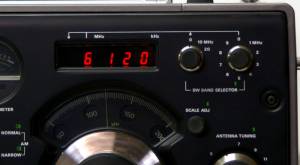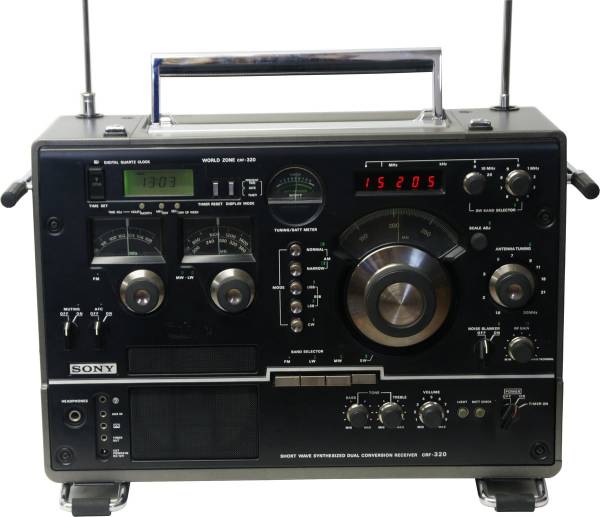Inhaltsverzeichnis
Sony CRF-320A
Manufactured by Sony, Corp., Tokyo.
In 1976, Sony launched the CRF-320, a high-priced portable world band receiver, which was not widely sold due to its high price tag of over DM 4000, but whose performance in the shortwave bands can still be compared with today's receivers. In contrast to the Grundig Satellit 3000 / 3400 receivers, the frequency processing of the CRF-320 based on stable 1 MHz signals and a VFO covering one MHz; it was no longer equipped with the turret tuner with its poor accuracy of the analog dials and its contact problems.

Technical data
- Frequency range: FM broadcast band, LW, MW, 30 x SW (1,000 - 29,999 MHz)
- Frequency display: digital display, 1 kHz
- Frequency memory: none
- Features: digital quartz clock, timer
- Sensitivity: AM (A3) 1 μV, SSB 0.3 μV; Selectivity: AM 10/16 kHz, 4.4/8 kHz, SSB 2.0/3.4 kHz (-6/-60 dB)
Power supply
- Mains operation: 110, 127, 220, 240 V
Dimensions
- 450 x 310 x 210 mm, weight 13 kg
Accessories
Operation
The quasi portable receiver, which has a weight of 13 kg with the batteries installed, has an anthracite coloured plastic cabinet. It is equipped with a sturdy carrying handle on its top, side handles with front panel protection and a protective cover for transport. With its dimensions of 45 x 31 x 21 cm, the receiver is just about portable, but can be operated as a tabletop receiver with its well-matched telescopic antennas and battery operation independently of the mains.
On the front panel there is a world time clock in the upper left corner, which allows timer operation, on the older model CRF-320 the clock is electrical, the newer CRF-320A has a digital quartz clock. Below this are the two semicircular dials for the FM broadcast band and long / mediumwaves, in these ranges the frequency is not displayed digitally. Underneath the dials are the switches for the squelch and the AFC for FM broadcast band reception.
 In the middle below the S-meter, which is unfortunately not calibrated in S-units, you find the operating mode pushbuttons and the band selectors. At the top of the right part of the front panel, you find the red LED frequency display and next to it the range selectors for the ten MHz and one MHz ranges on shortwaves. The whose shortwave spectrum is divided into 30 1-MHz segments. Below the frequency display, you find the great easy-to-grip main tuning knob. To the right of the tuning knob is the preselector labelled „Antenna tuning“, its setting is crucial for good peformance. Below this the switch for the noise limiter, which acts against the (Russian) over-the-horizon radar and ignition spark noise which caused much problems in the 1980s, and next to it the RF gain control.
In the middle below the S-meter, which is unfortunately not calibrated in S-units, you find the operating mode pushbuttons and the band selectors. At the top of the right part of the front panel, you find the red LED frequency display and next to it the range selectors for the ten MHz and one MHz ranges on shortwaves. The whose shortwave spectrum is divided into 30 1-MHz segments. Below the frequency display, you find the great easy-to-grip main tuning knob. To the right of the tuning knob is the preselector labelled „Antenna tuning“, its setting is crucial for good peformance. Below this the switch for the noise limiter, which acts against the (Russian) over-the-horizon radar and ignition spark noise which caused much problems in the 1980s, and next to it the RF gain control.
At the bottom, under a trim strip, you find the connectors for headphones, tape output and the timer control to activate a cassette recorder, the loudspeaker and the sound and volume control. The mains/timer switch is located further right.
 On the rear face of the receiver, above the battery and mains cable compartments, you find the screw terminal connectors for antennas for the FM broadcast band and an external shortwave antenna.
On the rear face of the receiver, above the battery and mains cable compartments, you find the screw terminal connectors for antennas for the FM broadcast band and an external shortwave antenna.
Technically, the CRF-320 is a double conversion superhet with semi-digital frequency processing. 1 MHz signals generated in a PLL circuit (selected by the MHz band switches) are mixed with the signal of a linear variable oscillator (VFO frequency 3.455 - 2.455 MHz) to generate the first intermediate frequency of 45.145 MHz. Since the IF is higher then the reception range, mirror signals can be effectively be avoided.
The RF signal has to pass a 35 MHz low-pass filter and is fed to the first mixer. After an electronical five band preselection and after the tuneable preselector, the signal is converted to the first intermediate frequency. The noise blanker eliminates signal peaks between the first and second mixer.
After the conversion to the second intermediate frequency of 455 kHz and an IF amplifier stage, the signal has to pass the IF filters, they are electronically switched with diodes. The signal then is fed to the AM diode demodulator or the SSB demodulator, here the BFO signal is added. With the CRF-320A, full SSB reception with the corresponding frequency offset for USB and LSB is possible.
In practical operation, first select the 1 MHz wide shortwave range with the 10 and 1 MHz switches and then set the corresponding frequency with the main tuning knob, the frequency can be read from the digital display and from the analogue dial both with an accuracy of 1 kHz. The next important step is the optimal tuning of the preselector; if the preselector is in an incorrect position, reception is hardly possible and the receiver may appear „deaf“. After the preselector is tuned correctly, the S-meter swings far to the right and the station booms in.
A somewhat inconvenient aspect of this receiver concept is, that when you check several parallel frequencies in different shortwave bands, the preselector must be readjusted each time. In fully microprocessor controlled receivers with electronic preselection (like the NRD-535) this is done automatically. In other cheap PLL receivers the preselection is omitted, which leads to the appearance of „mirror frequencies“ at unexpected places on the dial (and the signal from Lomé in the tropical band on the hour turns out to be the mirror frequency of the French service of the VOA…). With the CRF-320A, don't expect such surprises; it is worth discovering the remaining African stations in the tropical bands with a receiver with such a noble feeling when tuning.
 In Summary, the CRF-320A, which was the dream receiver of many in the 1980s, is still an excellent receiver for Dxing for fixed and semi-mobile operation. With the CRF-320A you can go wave hunting without setting up long external antennas and worrying about the 220 V supply, some gimmicks such as electronic station memories, passband tuning and notch filter make the difference to semi-professional receivers.
In Summary, the CRF-320A, which was the dream receiver of many in the 1980s, is still an excellent receiver for Dxing for fixed and semi-mobile operation. With the CRF-320A you can go wave hunting without setting up long external antennas and worrying about the 220 V supply, some gimmicks such as electronic station memories, passband tuning and notch filter make the difference to semi-professional receivers.
Technical principle
Double conversion, analogue technology.
Components
The set is fully equipped with semiconductors.








